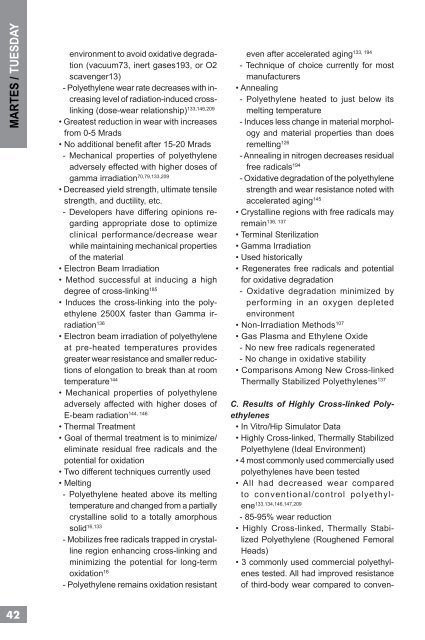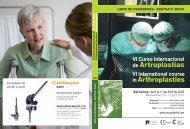cadera / hip - Active Congress.......
cadera / hip - Active Congress.......
cadera / hip - Active Congress.......
You also want an ePaper? Increase the reach of your titles
YUMPU automatically turns print PDFs into web optimized ePapers that Google loves.
MARTES / TUESDAY<br />
42<br />
environment to avoid oxidative degradation<br />
(vacuum73, inert gases193, or O2<br />
scavenger13)<br />
- Polyethylene wear rate decreases with increasing<br />
level of radiation-induced crosslinking<br />
(dose-wear relations<strong>hip</strong>) 133,146,209<br />
• Greatest reduction in wear with increases<br />
from 0-5 Mrads<br />
• No additional benefi t after 15-20 Mrads<br />
- Mechanical properties of polyethylene<br />
adversely effected with higher doses of<br />
gamma irradiation70,79,133,209 • Decreased yield strength, ultimate tensile<br />
strength, and ductility, etc.<br />
- Developers have differing opinions regarding<br />
appropriate dose to optimize<br />
clinical performance/decrease wear<br />
while maintaining mechanical properties<br />
of the material<br />
• Electron Beam Irradiation<br />
• Method successful at inducing a high<br />
degree of cross-linking185 • Induces the cross-linking into the polyethylene<br />
2500X faster than Gamma irradiation136<br />
• Electron beam irradiation of polyethylene<br />
at pre-heated temperatures provides<br />
greater wear resistance and smaller reductions<br />
of elongation to break than at room<br />
temperature144 • Mechanical properties of polyethylene<br />
adversely affected with higher doses of<br />
144, 146<br />
E-beam radiation<br />
• Thermal Treatment<br />
• Goal of thermal treatment is to minimize/<br />
eliminate residual free radicals and the<br />
potential for oxidation<br />
• Two different techniques currently used<br />
• Melting<br />
- Polyethylene heated above its melting<br />
temperature and changed from a partially<br />
crystalline solid to a totally amorphous<br />
solid16,133 - Mobilizes free radicals trapped in crystalline<br />
region enhancing cross-linking and<br />
minimizing the potential for long-term<br />
oxidation16 - Polyethylene remains oxidation resistant<br />
133, 194<br />
even after accelerated aging<br />
- Technique of choice currently for most<br />
manufacturers<br />
• Annealing<br />
- Polyethylene heated to just below its<br />
melting temperature<br />
- Induces less change in material morphology<br />
and material properties than does<br />
remelting126 - Annealing in nitrogen decreases residual<br />
free radicals194 - Oxidative degradation of the polyethylene<br />
strength and wear resistance noted with<br />
accelerated aging145 • Crystalline regions with free radicals may<br />
136, 137<br />
remain<br />
• Terminal Sterilization<br />
• Gamma Irradiation<br />
• Used historically<br />
• Regenerates free radicals and potential<br />
for oxidative degradation<br />
- Oxidative degradation minimized by<br />
performing in an oxygen depleted<br />
environment<br />
• Non-Irradiation Methods107 • Gas Plasma and Ethylene Oxide<br />
- No new free radicals regenerated<br />
- No change in oxidative stability<br />
• Comparisons Among New Cross-linked<br />
Thermally Stabilized Polyethylenes137 C. Results of Highly Cross-linked Polyethylenes<br />
• In Vitro/Hip Simulator Data<br />
• Highly Cross-linked, Thermally Stabilized<br />
Polyethylene (Ideal Environment)<br />
• 4 most commonly used commercially used<br />
polyethylenes have been tested<br />
• All had decreased wear compared<br />
to conventional/control polyethylene<br />
133,134,146,147,209<br />
- 85-95% wear reduction<br />
• Highly Cross-linked, Thermally Stabilized<br />
Polyethylene (Roughened Femoral<br />
Heads)<br />
• 3 commonly used commercial polyethylenes<br />
tested. All had improved resistance<br />
of third-body wear compared to conven-





